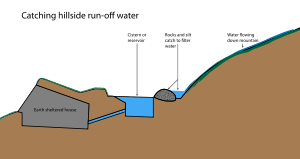Stormwater harvesting
Stormwater harvesting or stormwater reuse is the collection, accumulation, treatment or purification, and storing of stormwater for its eventual reuse. It differs from rainwater harvesting as the runoff is collected from drains or creeks, rather than roofs.[1][2] It can also include other catchment areas from man made surfaces, such as roads, or other urban environments such as parks, gardens and playing fields.
A main challenge stormwater harvesting poses is the removal of pollutants in order to make this water available for reuse. Stormwater harvesting is practiced across the United States in Texas and other States as a way to address rising demands as populations rise. Internationally, Australia has been a country also active in stormwater harvesting.[3]
Water that comes in contact with impervious surfaces becomes polluted and is denominated surface runoff. As the water travels more distance over impervious surfaces it collects an increasing amount of pollutants.
Concerns
Major concerns in new projects for stormwater harvesting include cost effectiveness as well as quality, quantity, and reliability of the reclamation, as well as existing water management infrastructure and soil characteristics.[3] Some project cost estimates have produced results for stormwater being around twice as expensive factoring operating cost per unit versus potable water alternatives.[3] However, other benefits include reducing soil erosion and reducing demands on local aquifers, as well as reduction of pollution into local waterways.[3]

Systems
Ground catchments systems channel water from a prepared catchment area into storage. Generally they are only considered in areas where rainwater is very scarce and other sources of water are not available. If properly designed, ground catchment systems can collect large quantities of rainwater.
Stormwater Capture
Five Core Steps: "End Use, Collection, Treatment, Storage, and Distribution".[4]
- End Use
- Water sources become scarce as the population grows. People need to come up with methods to recycle water at the end of its use. For non-portable water purpose of lower water quality, people use stormwater for toilet flushing, gardening, fire fighting, irrigation and etc. For potable water use of higher water quality, stormwater needs to be treated before putting into use. The latter has been rarely used around the world.[4]
- Collection
- Stormwater collection is a process of directing water into a storage from stormwater gathering, such as urban runoff. Generally, there are two types, online storages and offline storages. Online storages are a conventional way of acquiring stormwater directly from waterways or drains. For instance, the urban drainage system of channels and pipes conduct stormwater into storages. One inconvenient part of the drainage system is to keep maintenance in case that conduits break and stormwater leaks away. Based on online storages, another drainage system called WSUD is featured. Offline storages require additional facilities to conduct water from waterways indirectly For instance, weirs divert low flows into the stormwater container and contribute to a large part of stormwater catchment for a city.[4]
- Treatment
- Stormwater treatment is what mostly hinders the progress of stormwater catchment. Water treatment process depends on the intended end use and the catchment equipment, which decides the level of and size of the pollutants to be filtered and removed. Generally, the steps applied for different end uses vary. For instance, as construction uses may not require high-quality water. The water recycling includes only filtration and disinfection. However, for potable uses of higher water quality, the treatment process requires screening, coagulation, filtration, carbon adsorption, and disinfection.[4]
- Storage
- There are three factors to consider in terms of storage: function, location and capacity. For function, the planner is responsible for deciding the purpose of the stored stormwater, such as fire fighting, industrial water supplies, farming and irrigation, recreational amenity and flood mitigation. For location, to establish a water tank or an injection system to aquifers above or below the ground should be considered. Besides, choices between online and offline storages can affect the surrounding natural aquatic system and yields different maintenance costs and flood mitigation effeteness. The capacity of a storage relies on the demand of the end use in a particular climate or period.[4]
- Distribution
- Generally, there are two types of stormwater distribution systems. The first one is open space irrigation systems. The other one is non-potable distribution systems. Some key points are underscored in terms of designing an appropriate distribution system: "Consideration of customer requirements; Adjusting design criteria; Selecting design peak factors; Methods for peak leveling; Controlling distribution non-potable water; Minimisation of bacterial and algal build up; Corrosion risk and so forth".[4]
See also
- Rainwater harvesting
- Rainwater Hog
- Stormwater detention vault
References
- http://www.environment.nsw.gov.au/resources/stormwater/managestormwatera06137.pdf page 10
- "Rainwater harvesting 2012". 2012. Archived from the original on 2013-06-06. Retrieved 2012-11-01.
- "Stormwater Harvest Guidance Document for Texas Water Development Board (2010)" (PDF). www.twdb.texas.gov. pp. 1–1, 2–3, 2–24, 2–28. Retrieved 2017-08-26.
- McMahon, Joseph (October 2008). "Review of Stormwater Harvesting Practices". Urban Water Security Research Alliance Technical Report – via ResearchGate.